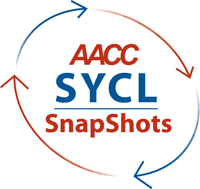
SYCL SnapShots
Welcome to SYCL SnapShots, a recurring feature in CLN describing essential skills and practices for effective laboratory management. Here, members of AACC's Society for Young Clinical Laboratorians (SYCL) present a snapshot of a topic, such as business basics, data analysis and statistics, and online tools. More information about SYCL is available online.
 Christopher McCudden, PhD
Christopher McCudden, PhD
SYCL Chair
The Ottawa Hospital
Ottawa, Ontario, Canada
Email: [email protected]
Getting the Word Out
Five Tips for Creating a Newsletter People Will Read
By Angela Ferguson, PhD, DABCC, FACB, and Shannon Haymond, PhD, DABCC
Communicating with clients, colleagues, and staff is an important part of many laboratory professionals' jobs today. Consider the following situations: your laboratory or organization plans to launch a new test or service; the laboratory staff think it would be a good idea to provide educational information about test utilization to clinicians; or the laboratory director wants to share data from a quality improvement project with others in the institution. A newsletter can be an effective and efficient way to share such information.
The first thought that may come to mind when you picture a newsletter is a folded piece of paper that arrives in your mailbox. Of course today, electronic newsletters serve a vital role in disseminating information. In particular, they can be easily indexed, archived, and referred to at a later date. However, whether information is printed or electronic, all forms of communication compete for attention in an increasingly crowded information environment.
Whether you are considering starting a newsletter or are responsible for editing and publishing an existing newsletter, the five tips below will improve your chance of writing a newsletter that people will read.
Identify the Audience
A newsletter might have several target audiences. For example, when describing implementation of a new test, clinicians will need to know how this test impacts their practice. However, they are probably not so interested in the details of analyzer platform comparison, despite the debate it produced among the laboratory staff.
Define the Purpose and Tailor the Content
Focus on providing news your readers can use. If you are publishing a newsletter from your laboratory to communicate changes and enhancements in your operation, you may want to focus on topics related to availability of new tests or services. Providing some educational background on the test with related troubleshooting and how-to content is a good idea.
Another good topic for a laboratory newsletter is information on the laboratory itself. You may want to include descriptions of different sections of the laboratory, as well as information on the technology in the lab and the skills of the staff. Providing solutions to commonly encountered problems or questions from readers will engage your audience and encourage interest in future issues of the newsletter.
Announcements of upcoming events, accomplishments, and progress on the lab's quality improvement or other projects are also good topics. You may also want to describe results and list publications from current research and process improvement projects as a way to foster collaborations with readers.
Overall, it is important to keep the information simple and timely. To keep readers engaged, get creative with a variety of content, balancing longer, substantial review articles with shorter pieces, interviews, and announcements.
Determine the Format
Once you have determined for whom you are writing and how to focus your content, you will need to determine the format of the newsletter. Readers like regularity and ease-of-use; therefore, it is best to keep the format consistent.
You should also give some thought to how the newsletter will be received and read. Electronic versions are the most cost-effective format. Using a format that is readable on a smartphone or other personal device also gives readers greater accessibility. Another option is to publish the newsletter as a portable document file or PDF. Other paperless methods include web-based HTML newsletters, where short, one-to-two phrase summaries precede a link that directs readers to a website for more detail and content. If you choose an HTML format because it offers enhanced visual content, be aware that some formats require the user to download the file, which can be slow. In addition, web-based formats do not lend themselves to printing out the entire issue, but they offer readers an easy way to click on an article of interest without paging through the entire document.
Sending an email that contains the newsletter as text in the body of the message is also popular, but requires a compelling subject line to attract attention and prevent your message from being ignored and deleted. Including an "in this issue" statement as the subject line or an outline at the start of the email helps attract readers' attention.
Regardless of the format you choose, you should make it visually appealing and easy to read. A consistent look and logical, uncluttered design enhance newsletter readership.
Set a Schedule
Next, decide on a publication schedule and stick to it so your audience anticipates each issue. Plan content in advance and provide contributors with clear guidelines and due dates, making sure to build in adequate time for article submission and follow-up as deadlines approach.
Re-purposed content also can help with keeping the publication on schedule. Information that was presented at staff or committee meetings, as well as a scientific meeting, often makes excellent content for distribution to a wider audience in a newsletter. It's a good idea to seek expert contributors to vary the perspective and increase the standing of your newsletter.
Promote the Newsletter
Even a well-designed and carefully crafted newsletter will have low readership if your distribution method is flawed. To increase visibility, promote the newsletter using many different forms of electronic media, such as relevant email distribution lists and available daily news communications sent to your target audience. Other options include distributing the newsletter on relevant professional listservs or placing links on websites, blogs, or social media outlets frequently visited by your target audience. Include a forward-to-a-friend button and links for readers to subscribe or join a mailing list.
The Reward
Creating a newsletter is a rewarding activity. Not only do newsletters allow you to communicate with others in your organization, but they also allow you to reach out to new customers, or others with similar interests. We encourage you to consider starting a newsletter for your laboratory, business, or interest group and hope that these tips help you to make it a success.

Angela Ferguson, PhD, DABCC, FACB, is assistant director of clinical chemistry at Children's Mercy Hospitals and Clinics in Kansas City, Mo., and an assistant professor at the University of Missouri Kansas City School of Medicine. She moonlights as the editor of The Monitor, the newsletter for the Pediatric and Maternal-Fetal Division of AACC.

Shannon Haymond, PhD, DABCC, is director of clinical chemistry at Ann & Robert H. Lurie Children's Hospital of Chicago and an assistant professor at the Northwestern University Feinberg School of Medicine.
The authors have nothing to disclose.